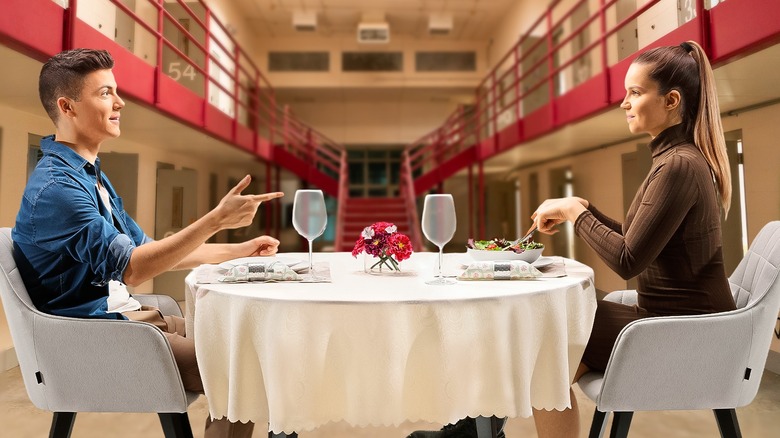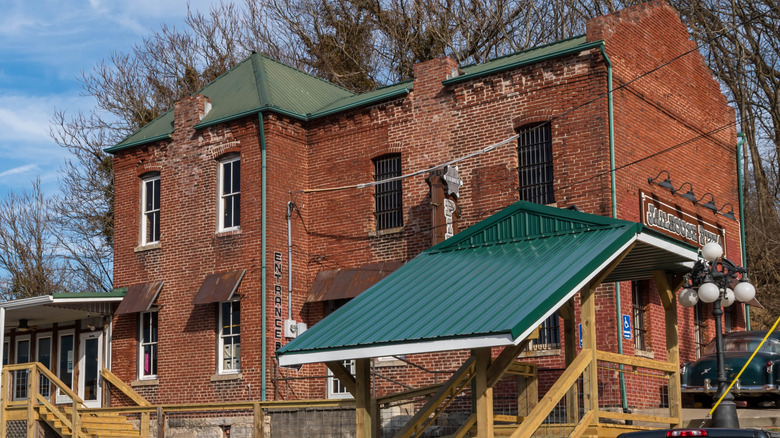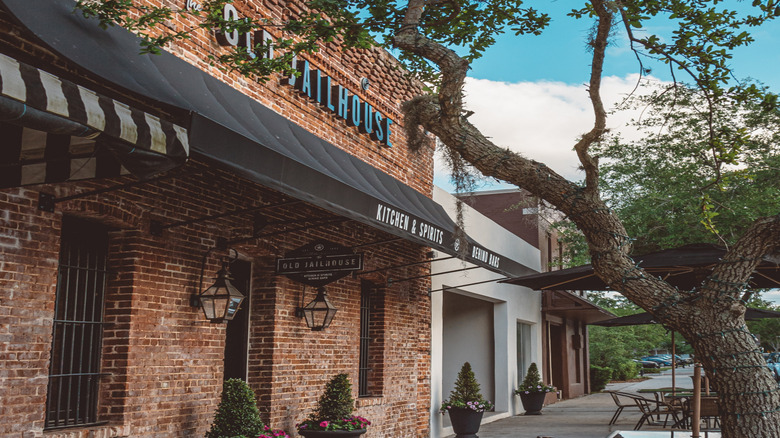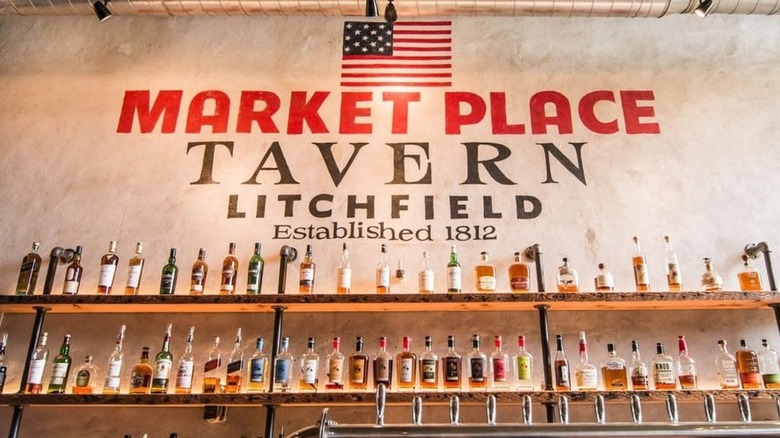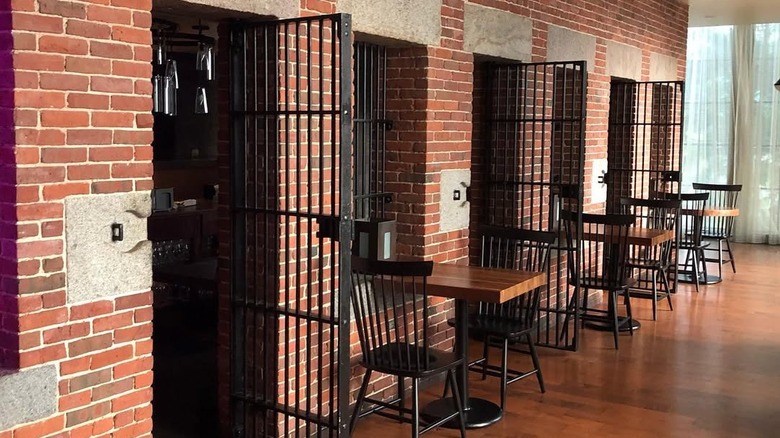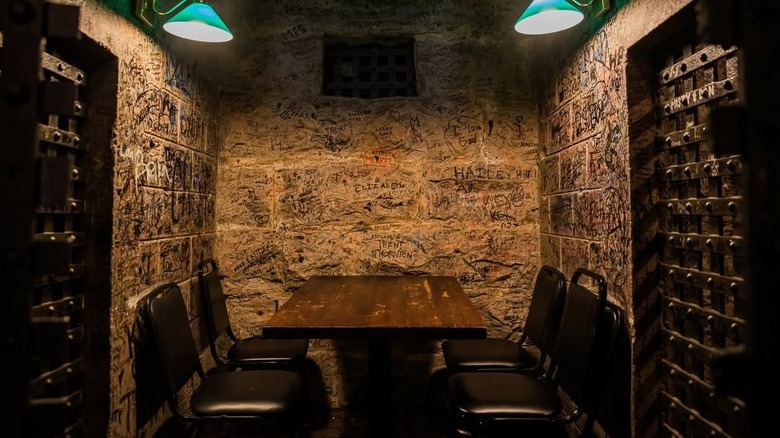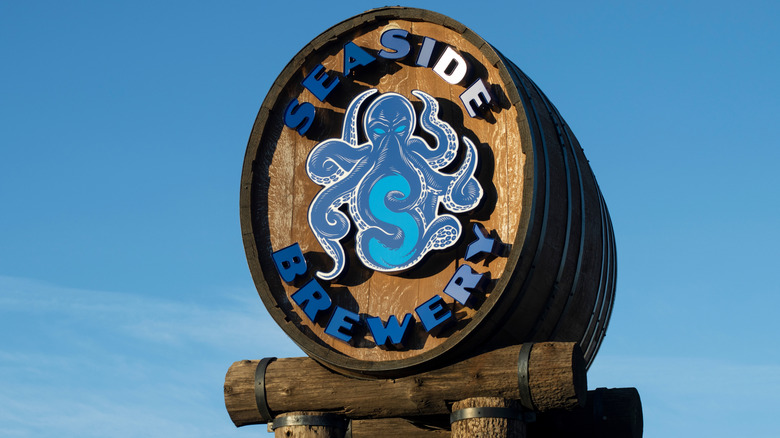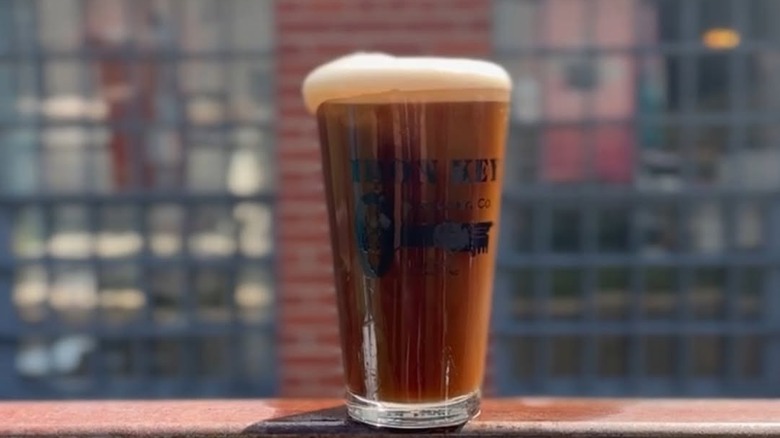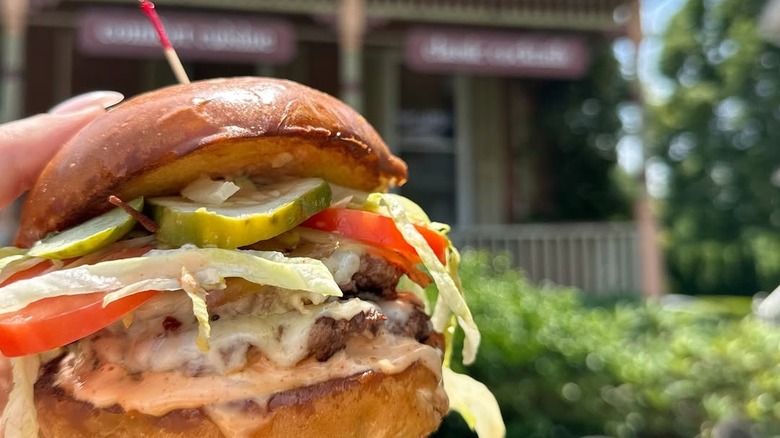Old Jails Around The US That Are Now Restaurants
Getting sent to prison is held up as one of society's roughest punishments or corrective measures, with one being denied their very freedom to move around and pursue a life as recompense for being found guilty of hurting another person or society at large. There's little to like in prison, with the conventional wisdom suggesting that it's boring, scary, and with little to do. Even the food is bad, depicted as industrial, processed, unappetizing slop. The intersection of food and prison is important. Prisons need better food, prison labor could be fueling the fast food industry, and an early 2000s Food Network star's career ended with a prison sentence.
But what if going to prison wasn't so bad? What if it were actually a good thing — and specifically, what if the food was probably great to excellent? That's the question that some clever restaurateurs all over the United States asked themselves — and then answered by turning decommissioned or disused jails, holding cells, and prisons into interesting eateries. They've essentially opened interactive museums with pretty good food out of buildings that were just rotting away, filled with a history of misery. Here are 12 restaurants around the country built out of incarceration facilities where one can also learn a little bit about prison life.
Jailhouse Pizza: Brandenburg, Kentucky
Countless restaurants have put up a plaque or a signed headshot commemorating a years-ago visit from a big celebrity. Jailhouse Pizza has got to be about the only restaurant that brags about how it was once briefly the home of country music legend Hank Williams, back when the building was the Meade County Jail. From 1906 to 1976, people in and around Brandenburg, Kentucky, that were arrested and deemed a threat to the community were held for a while in this small, two-story brick jail. Long after it was decommissioned, and it hadn't been remodeled or demolished, the proprietors of Jailhouse Pizza took over the jailhouse and made it into a prison-themed restaurant.
While the upstairs level has cells where visitors can play around and take pictures, the ground floor features booths sitting inside of old cells, with doors that lock if customers want to experience that particular part of being in jail. It is also the home of one of America's most intense restaurant food challenges, the Prisoner's Pardon, which requires two people to get through a huge 30-inch, 12-pound pizza in under an hour. Otherwise, the food is mostly brick oven-cooked pies and wings, including a Jailhouse Special pie.
The Old Jailhouse: Sanford, Florida
A sturdy, but otherwise nondescript building was among the first structures erected in downtown Sanford, Florida. From 1890 to 1895, it housed a blacksmith and wagon repair facility, and for a few years in the 1910s, the business inside sold horse feed and rented our horses, mules, and buggies. That endeavor died right around the time that the Florida legislature incorporated Seminole County, and as the jurisdiction would need a jail, the local government acquired that retail building. It was converted into the Seminole County Jail, with bricks and bars added to the building for extra security to differentiate it from the more welcoming establishments.
The building hasn't had any prisoners in it since 1959, and in 2018 it was restored by the owners of The Old Jailhouse restaurants to its old, jailhouse look with the original implements emphasized including bars on windows, operational cells, and eerily faded and discolored brick walls. The food is decidedly different than what one would usually get in a prison. The Old Jailhouse serves chef-forward fare inspired by Southern traditional cooking, offering braised pork belly, buttermilk chicken served with green beans and mac and cheese, and garlic whipped mashed potatoes.
Market Place Tavern: Litchfield, Connecticut
The stark, gray brick exterior of the Market Place Tavern claims that the business was established in 1812, which would make it one of the oldest restaurants in the United States. That's a misleading claim, however. Because while the Market Place Tavern, next to the Litchfield Green in Litchfield, Connecticut is a restaurant and event space, that's only been the case for a few years. The spot is the town's oldest public building, constructed in 1812 as a war prison for British soldiers captured during the War of 1812. A three-level wing of cell blocks was built on in 1846, and the place was a criminal prison until 1992 before being converted into an inmate services facility until the state sold it off for private use.
The new owners didn't so much gut the place as they did embrace the prison look and vibes. The cells that look down on the three-story bar are unchanged, and so are the bars on the windows that obscure views of the Litchfield Green. The menu is extensive, loaded with classed-up takes on classic American pub fare that don't bear a trace of a prison influence, with roasted halibut, tavern meatloaf, and New York strip steaks standing out.
Clink.: Boston, Massachusetts
Inside of The Liberty Hotel on Beacon Hill in Boston is a restaurant that purportedly "serves the freshest North Atlantic seafood, seasonal New England fare, heirloom produce, and artisanal heritage meats" according to its website. Along with the special themed dinners and chef-crafted meals paired with specially chosen wines, that promise adds to the atmosphere of an upscale place that doesn't make much reference to what used to happen on site — apart from its name. It's called Clink. (period included) — as in the sound of metal cell doors slamming and locking shut. Clink. serves breakfast, brunch, lunch, and dinner, where you can grab a "Chef's Tasting Board" of small-batch cheeses and charcuterie to precede a meal of perfectly seared scallops, salmon, or house-made pasta.
Cells with entryways cut out of brick walls with barred off windows loom everywhere inside of Clink., part of a hospitality complex since 2000 that includes a luxury hotel and several restaurants and bars. When the building went up in 1851, it was The Charles Street Jail, a prison so harsh, daunting, and allegedly cruel to prisoners that it was shut down by the state in 1990. Still, it held prisoners for a century, including such famous inmates like anarchists Sacco and Vanzetti and civil rights leader Malcolm X.
Cahoots Restaurant: Fayetteville, Tennessee
Among the oldest extant structures in Fayetteville, Tennessee, is Cahoots, a restaurant that from the outside, with its mirrored square facade and green awning, resembles an '80s singles bar. The inside looks much the same as it did as when it was built in 1867, although it feels even older, medieval even. That's because Cahoots used to be a calaboose, or a small prison, as well as a firehouse, known locally as The Old Calaboose on Fire Hall Hill. The building was cut from a huge deposit of limestone, and the primitive, dark cells were carved out of the interior. Prisoners who did their time were shackled to metal rings inserted into the rock walls, residing in portable cells that, when necessary, were pulled by pack animals to take the inmates to their jobs in Fayetteville and surrounding parts to build and repair roads.
Casual diners and planned parties can now visit Cahoots, a restaurant that still looks like an ancient prison. Tables are placed in individual rooms, or cells, set off by heavy metal sliding doors. Back when it was The Old Calaboose, the menu was likely more meager and provided the bare amount of nutrition for prisoners. Today, Cahoots sells stuff like gigantic build-your-own appetizer platters, five different kinds of burritos, homemade tuna salad sandwiches, lots of burgers, and a kids' menu where a ribeye steak is an option.
Margarita's Mexican Restaurant: Concord, New Hampshire
There are 20 Margarita's Mexican Restaurant locations serving the greater northeastern U.S. and New England population, with eight of those eateries just in New Hampshire. Some are purpose-built, while others operate out of some of the state's oldest buildings that would otherwise have lay vacant. One such Margarita's, right in the heart of Bicentennial Square in the capital city of Concord, is of particular interest because it occupies a space that used to be occupied by prisoners. The very first entry in the chain opened in 1985 in what was once Concord's police headquarters building. Such a facility needed a way to hold prisoners on a short-term basis at the very least, and so it had some cells on the premises. Today, those cells and maze-like layout are some of the most sought after spots on the premises to enjoy tacos, enchiladas, and 10 different kinds of fajitas.
During its prison era of 1890 to 1975, this Margarita's witnessed the comings and goings of plenty of prisoners, but one reportedly never left. It's supposedly watched over by a ghost named George, making Margarita's one of America's most haunted restaurants.
Main Street Café: Madison, Alabama
Visitors can expect to enjoy a lot of Southern history when they dine at the Main Street Café in Madison, Alabama. Such time traveling into the past can come in multiple forms, such as in the cuisine and exploring what used to happen on the site of the restaurant. The Main Street Cafe is situated right off the street, and looks like a teahouse or lunchroom with its black-and-white color scheme, accented by pillars, plants, and lanterns. On the menu is a combination of Cajun and Creole-inspired seafood dishes as well as old-fashioned, Southern homestyle favorites such as fried green tomatoes, barbecue, and pimiento cheese-stuffed chicken.
The Main Street Café has served the area for more than two decades out of a space leased from the city, which used it as Madison's third city hall building since about 1955. Many government services and functions were carried out there, including holding local law-breakers. There were two cells still left from when the building was city hall, and the Main Street Café uses them as private dining rooms.
Seaside Brewery: Seaside, Oregon
Oregon isn't really known for its barbecue as much as some other states, but the Pacific Northwest state is legendary for its rich and historical culture of craft beer brewing. In 2012, the sparsely populated beach town of Seaside welcomed its first brewery when beermakers and restaurateurs Vince Berg and Jimmy Griffin opened Seaside Brewery. Those proprietors have since playfully marketed their establishment as the only former jail in the state of Oregon where the sale and consumption of beer is allowed if not encouraged. The daunting, sea-weathered, two-story brick building that's now a brew pub and restaurant was formerly the old City Jail. Built more than 100 years ago, the facility has been variously the home of local needs like a firehouse and City Hall, and the prison remnants remained. The jail bars and other solid, secure parts of the structure haven't gone anywhere, nor have the naturally distressed wooden floors and faded brick.
Seaside Brewery pours numerous craft beers from around Oregon as well as its owners' own brewed creations. That complements a menu bursting with meat and variety that certainly wasn't ever served when the building was a jail, such as at different styles of barbecue and items like pulled pork, smoked sausage, and brisket.
Iron Key Brewing: Columbus, North Carolina
There's no mistaking that Iron Key Brewing in Columbus, North Carolina, was once a large state prison. Built from bricks and adorned with double barred windows, the restaurant and brewery is still looked over by an adjacent if dilapidated guard tower. That deeply institutional and well-lit main building first opened in 1932 as an affiliate of the North Carolina State Prison system, and likely resembled on the interior and the exterior about 50 other correctional facilities erected at the same time. Photos and visitations weren't allowed at any of North Carolina's prisons in the early 20th century, so there aren't a lot of solid accounts of what daily life was like in the Columbus facility, but the barbed wire fences, warden's office, dining hall, laundry, and solitary confinement area are still around and worth a look before or after a meal at Iron Key Brewing, opened for business since 2020. The key that can open the huge steel doors on the outside hangs framed on the back wall of the destination restaurant's bar.
Along with about 10 house-made beers that are always on tap, Iron Key Brewing serves from a bill of fare that's laced with prison words. The Big House Pretzel, Brussels on Probation, and Cell Block Pimento Cheese are fine starts to a meal of sandwiches, burgers, and other pub grub.
The Jailhouse: Belmont, North Carolina
In the moderately sized North Carolina city of Belmont (population: 15,000), what was once the town's one and only police station shared a wall with its related neighbor, the local jail, which temporarily housed miscreants and misbehavers. In 2007, the long since abandoned, 100-year-old police station became the Old Stone Steakhouse. Just about a decade later, that restaurant wanted to expand and it acquired the next-door property, the similarly unused city jail, and made it a logical extension of the steakhouse business. In 2017, The Jailhouse, a whiskey, cocktail, and cigar bar, officially opened.
While it's an explicitly high-end and classy establishment, touches of prison life from a century past inform the decor. Photos of the prison's history adorn the walls in former cells that are now isolating concrete-walled rooms, while portions of walls where inmates once scribbled their thoughts were preserved and moved to hang around leather booths. The bar is made of stark and sterile-seeming stainless steel, where patrons can order drinks as well as shareable plates, flatbreads, burgers, and salads.
Boone County Jail Distillery: Lebanon, Indiana
Most jails and prisons that have been converted into restaurants, brew pubs, and bars are able to romanticize their histories due to the softening effect of the passage of time. The Boone County Jail Distillery doesn't have that going for it. It was a functioning incarceration unit up until the relatively recent year of 1992.
When the Indiana legislature asked for a Boone County seat in 1832, residents picked Lebanon. Almost immediately, the town built a jail — a wooden outbuilding next to the courthouse — and in the 1880s made a more permanent structure on the same block. The Boone County Jail was in use until a new, modern complex was constructed in the '90s, at which point siblings Sean and Nicki Stoller transformed the structure into an alcohol distillery. In the 2020s, the company still makes vodka, gin, bourbon, and whiskey in the ex-jail, which go into the dine-in menu's cocktails, served to guests inside of cramped cells with low-ceilings with the original metal bars and doors still in service.
Harrie's Jailhouse: Middletown, Connecticut
On its website, Harrie's Jailhouse of Middletown, Connecticut, doesn't make a big deal about its past as a place where known or suspected criminals were held against their will for the sake of public safety. It appears to be a cozy, small-town restaurant with a solid menu of comfort food and crafted cocktails that operates out of a two-story brick home with lots of homey architectural features. That name, however, makes a mind wander, and Harrie's Jailhouse indeed has a colorful history. It's now a pub with a creatively upgraded menu, and before that it was a private house, but before that it was the town slammer. When Middletown authorized the structure in the 1850s, it was the Pameacha Jailhouse. And thus it functioned for decades.
Dining goes down mainly on the first floor and on the patio, while the basement bar is a more raucous spot. Upstairs, one can feast on prison-alluding entrees like the Folsom Chicken sandwich and the Jailbird, while downstairs they get to eat disco fries, scratch-made Chex Mix, and other items that definitely weren't doled out to prisoners in the 19th century.
